AMD Ryzen 9 5980HS Cezanne Review: Ryzen 5000 Mobile Tested
by Dr. Ian Cutress on January 26, 2021 9:00 AM EST- Posted in
- CPUs
- AMD
- Vega
- Ryzen
- Zen 3
- Renoir
- Notebook
- Ryzen 9 5980HS
- Ryzen 5000 Mobile
- Cezanne
CPU Tests: Simulation
Simulation and Science have a lot of overlap in the benchmarking world, however for this distinction we’re separating into two segments mostly based on the utility of the resulting data. The benchmarks that fall under Science have a distinct use for the data they output – in our Simulation section, these act more like synthetics but at some level are still trying to simulate a given environment.
DigiCortex v1.35: link
DigiCortex is a pet project for the visualization of neuron and synapse activity in the brain. The software comes with a variety of benchmark modes, and we take the small benchmark which runs a 32k neuron/1.8B synapse simulation, similar to a small slug.
The results on the output are given as a fraction of whether the system can simulate in real-time, so anything above a value of one is suitable for real-time work. The benchmark offers a 'no firing synapse' mode, which in essence detects DRAM and bus speed, however we take the firing mode which adds CPU work with every firing.
The software originally shipped with a benchmark that recorded the first few cycles and output a result. So while fast multi-threaded processors this made the benchmark last less than a few seconds, slow dual-core processors could be running for almost an hour. There is also the issue of DigiCortex starting with a base neuron/synapse map in ‘off mode’, giving a high result in the first few cycles as none of the nodes are currently active. We found that the performance settles down into a steady state after a while (when the model is actively in use), so we asked the author to allow for a ‘warm-up’ phase and for the benchmark to be the average over a second sample time.
For our test, we give the benchmark 20000 cycles to warm up and then take the data over the next 10000 cycles seconds for the test – on a modern processor this takes 30 seconds and 150 seconds respectively. This is then repeated a minimum of 10 times, with the first three results rejected. Results are shown as a multiple of real-time calculation.
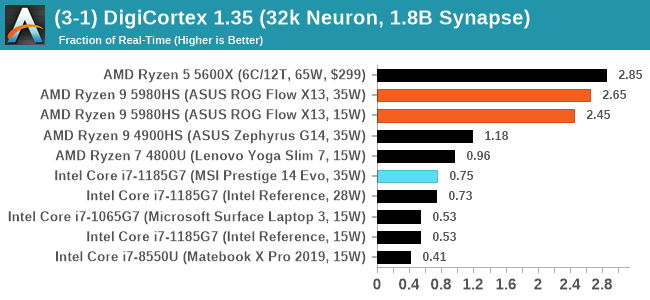
DigiCortex seems to have taken a shine to Zen 3, especially processors with a single chiplet of cores. Intel can't seem to compete here.
Dwarf Fortress 0.44.12: Link
Another long standing request for our benchmark suite has been Dwarf Fortress, a popular management/roguelike indie video game, first launched in 2006 and still being regularly updated today, aiming for a Steam launch sometime in the future.
Emulating the ASCII interfaces of old, this title is a rather complex beast, which can generate environments subject to millennia of rule, famous faces, peasants, and key historical figures and events. The further you get into the game, depending on the size of the world, the slower it becomes as it has to simulate more famous people, more world events, and the natural way that humanoid creatures take over an environment. Like some kind of virus.
For our test we’re using DFMark. DFMark is a benchmark built by vorsgren on the Bay12Forums that gives two different modes built on DFHack: world generation and embark. These tests can be configured, but range anywhere from 3 minutes to several hours. After analyzing the test, we ended up going for three different world generation sizes:
- Small, a 65x65 world with 250 years, 10 civilizations and 4 megabeasts
- Medium, a 127x127 world with 550 years, 10 civilizations and 4 megabeasts
- Large, a 257x257 world with 550 years, 40 civilizations and 10 megabeasts
DFMark outputs the time to run any given test, so this is what we use for the output. We loop the small test for as many times possible in 10 minutes, the medium test for as many times in 30 minutes, and the large test for as many times in an hour.
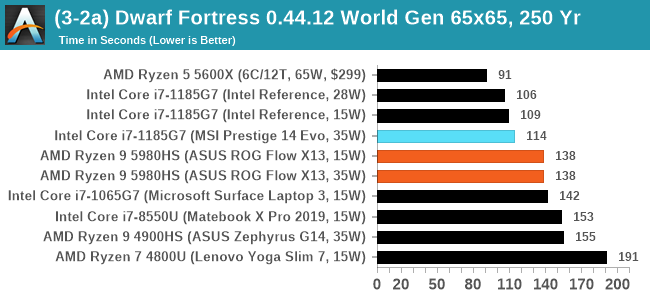
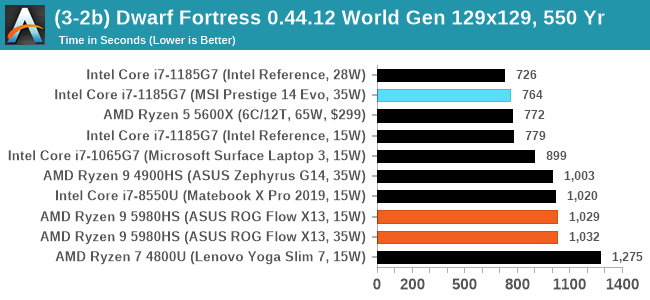
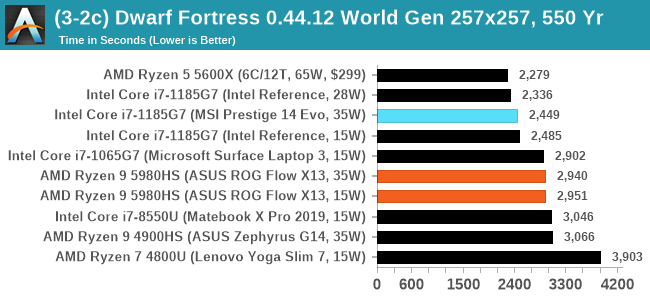
DF has historically been an Intel favorite, and we're not seeing much of a speedup for mobile Zen 3 over mobile Zen 2 here.
Dolphin v5.0 Emulation: Link
Many emulators are often bound by single thread CPU performance, and general reports tended to suggest that Haswell provided a significant boost to emulator performance. This benchmark runs a Wii program that ray traces a complex 3D scene inside the Dolphin Wii emulator. Performance on this benchmark is a good proxy of the speed of Dolphin CPU emulation, which is an intensive single core task using most aspects of a CPU. Results are given in seconds, where the Wii itself scores 1051 seconds.
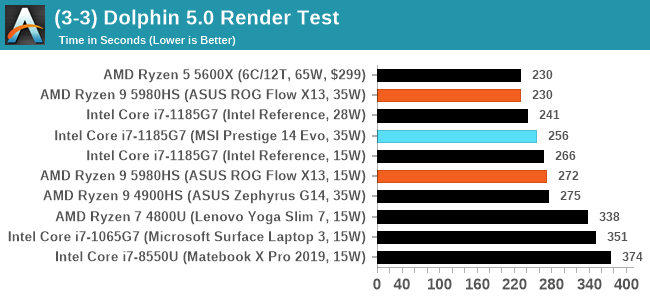
The 35W variant of Cezanne pushes through here, matching the desktop processor, and a sizeable performance jump over the previous generation Renoir.












218 Comments
View All Comments
Samus - Wednesday, January 27, 2021 - link
The 1660Ti has a higher TDP than the entire POWER SUPPLY of these test systems...GeoffreyA - Wednesday, January 27, 2021 - link
"1660ti or better is mandatory for any decent gaming"The iGPUs are a blessing to many people, especially those on a slender budget, like myself. One can actually play games on these and have a lot of fun.
ZoZo - Tuesday, January 26, 2021 - link
Indeed I didn't base my statement on the results in this test. I thought I remembered seeing 15W Tiger Lake vs 15W Renoir giving an edge to Tiger Lake.yeeeeman - Wednesday, January 27, 2021 - link
this test is comparing a 35W part iGPU to a 15W part iGPU. 1185G7 beats 4800U iGPU..schujj07 - Wednesday, January 27, 2021 - link
The only 15W CPU in this iGPU test is that of the 4800U. The 1185G7 is 28-35W and the other Ryzen's are 35W. The 4900HS has a RAM speed deficiency on the 1185G7 and wins 4 out of 7 tests.mikk - Thursday, January 28, 2021 - link
Because they are mostly CPU bound, it's primarily a CPU test! Look at the resolution. Anandtech lowered the resolution to 360p-480p low details in some of them to give Vega a chance to beat Xe. Furthermore Vega needs to clock at 2100 Mhz, a 55% clock speed advantage. No AV1 decoding either which is another big flaw for a mobile device.Spunjji - Friday, January 29, 2021 - link
@mikk - Pretty sure those results still aren't CPU bound, otherwise they'd be in the 100+fps range - and you'd expect Intel to win under those circumstances, because of their high single-thread performance. If Intel's iGPU only "wins" when they're both running sub-30 fps then it's a fairly meaningless win."Vega needs to clock at 2100 Mhz" - irrelevant. High clocks is only a disadvantage if it leads to worse power consumption, and that's not the case here. If Intel can increase their clocks within the same power envelope then they should.
Lack of AV1 decoding is a downside. It's not clear yet whether it will be a major one, but it shows the age of AMD's solution.
dotjaz - Friday, February 5, 2021 - link
That's called competition, honey. Don't have to beat it.Spunjji - Thursday, January 28, 2021 - link
You could have read the review to see that's not true. Xe routinely loses to Vega 8 in actual games, albeit not by a significant margin.Tams80 - Monday, February 1, 2021 - link
Xe does beat it, no doubt. But it's still pretty close and for integrated graphics Vega is good enough for another year.As mentioned in the article, they probably used Vega again mainly to ensure a quick release.